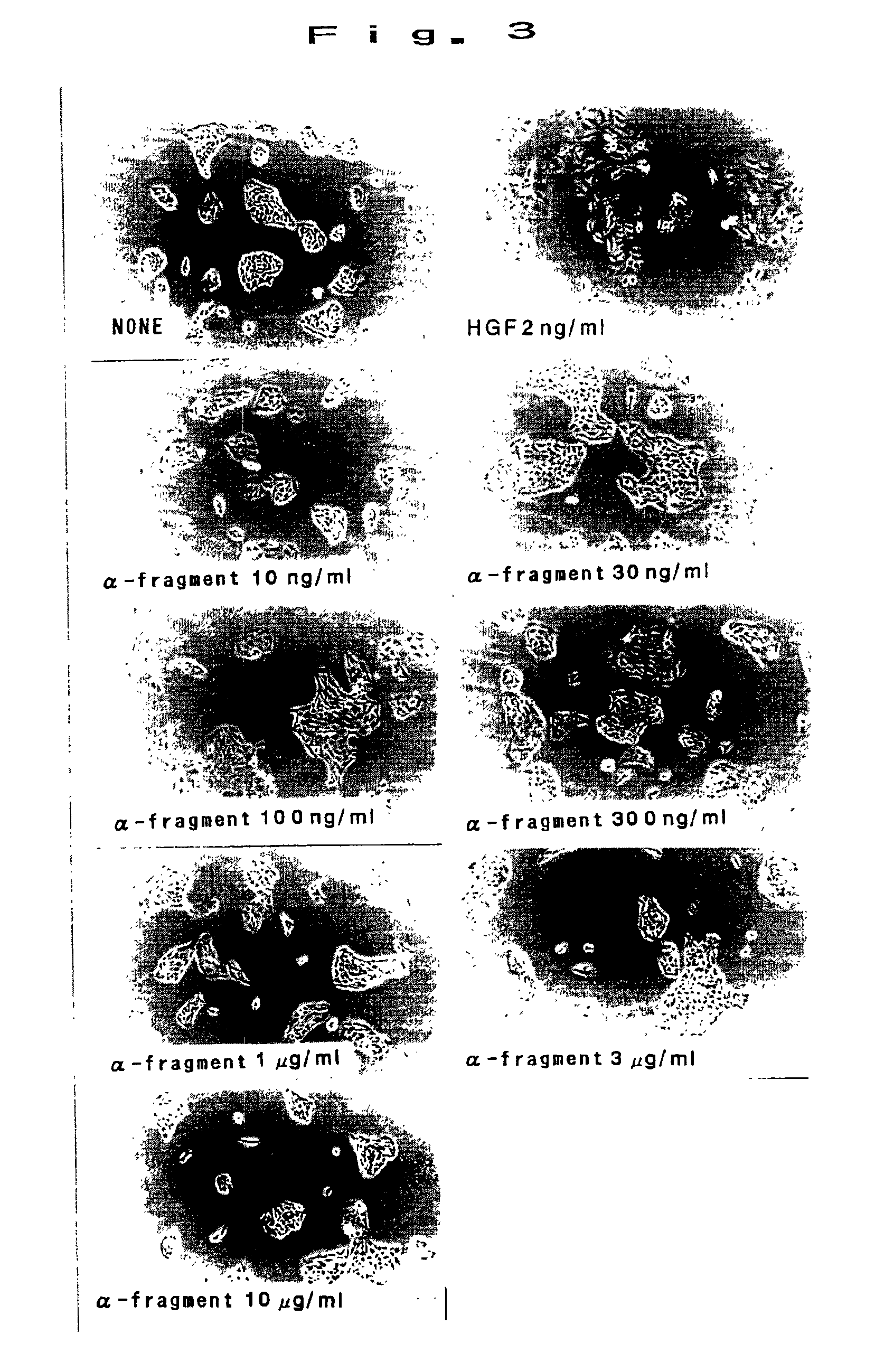Anti-cancer agent
a technology of anti-cancer agents and anti-cancer drugs, applied in the field of anti-cancer agents, can solve the problems of considerable limitation of use and loss of the belief that the drug was free of side effects
- Summary
- Abstract
- Description
- Claims
- Application Information
AI Technical Summary
Problems solved by technology
Method used
Image
Examples
example 1
[0047]Isolation and Refining of α-Fragment of HGF
[0048]900 mg of recombinant HGF was digested in elastase for 1 hour, and it was purified in reverse-phase HPLC (C4). Its chromatogram is shown in FIG. 1. As shown in FIG. 1, four peaks were obtained, and the first peak was identified to be α-fragment, the second peak to be undigested HGF, and third and fourth peaks to be β-1 and β-2, respectively. Further, by a freeze-drying system, the solvent was removed, and each of the fractions was collected and suspended again in distilled water. The obtained substances were found to be α and β-fragments by SDS-PAGE (see FIG. 2). The amino acid sequence of the α-fragment is shown by SEQ ID NO:1. As a result of determination of protein, 178 mg of α-fragment was obtained.
example 2
[0049]Analysis of Action of Motogen using MDCK Cells
[0050]MDCK cells were prepared in 2×104 cells / ml in 10% FBS added DMEM culture medium, and seeded in 48 well plates at 250 ml / well. By adding α-fragment alone in a range of 10 ng / ml to 10 mg / ml and cultivating for 24 hours, the surface was observed by a phase-contrast microscope. Results are shown in FIG. 3. As shown in FIG. 3, scattering action was not recognized in α-fragment. In succession, adding simultaneously with 2 ng / ml of HGF, the inhibitory effect on HGF was studied. Results are shown in FIG. 4 (in the photograph, the indication of “α” denotes the concentration of α-fragment (magnification), same hereinafter). As shown in FIG. 4, when exceeding the concentration of 1000 times, inhibition of scattering was observed dose-dependently. Thus, α-fragment was strongly suggested to be an antagonist of HGF.
example 3
[0051]Analysis of Action as Mitogen using Rat Liver Cells
[0052]Rat liver cells were cultivated on 38 well plates so as to occupy an area of about 50%, and HGF, EGF and α-fragment were added, and cultivated for 22 hours. By labeling with 125I-BrdU (0.15 mCi / well) for 4 hours, the activity was measured by scintillation counter. Results are shown in FIG. 5. In a range of 102 ng / ml to 104 ng / ml of α-fragment, the DNA synthesis promoting action was not recognized. When added simultaneously with 5 ng / ml of HGF, it was known that the mitogen activity of HGF was suppressed dose-dependently (see FIG. 5c). Hence, α-fragment was proved to be an antagonist to mitogen and motogen activity of HGF.
PUM
| Property | Measurement | Unit |
|---|---|---|
| weight | aaaaa | aaaaa |
| pH | aaaaa | aaaaa |
| action spectra | aaaaa | aaaaa |
Abstract
Description
Claims
Application Information
 Login to View More
Login to View More - R&D
- Intellectual Property
- Life Sciences
- Materials
- Tech Scout
- Unparalleled Data Quality
- Higher Quality Content
- 60% Fewer Hallucinations
Browse by: Latest US Patents, China's latest patents, Technical Efficacy Thesaurus, Application Domain, Technology Topic, Popular Technical Reports.
© 2025 PatSnap. All rights reserved.Legal|Privacy policy|Modern Slavery Act Transparency Statement|Sitemap|About US| Contact US: help@patsnap.com



